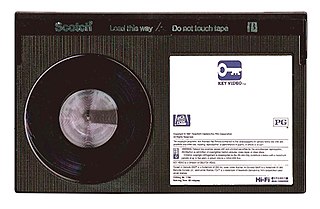
The compact disc (CD) is a digital optical disc data storage format that was co-developed by Philips and Sony to store and play digital audio recordings. In August 1982, the first compact disc was manufactured. It was then released in October 1982 and branded as Digital Audio Compact Disc.
Digital video is an electronic representation of moving visual images (video) in the form of encoded digital data. This is in contrast to analog video, which represents moving visual images in the form of analog signals. Digital video comprises a series of digital images displayed in rapid succession.

VHS is a standard for consumer-level analog video recording on tape cassettes.

DV refers to a family of codecs and tape formats used for storing digital video, launched in 1995 by a consortium of video camera manufacturers led by Sony and Panasonic. In the late 1990s and early 2000s, DV was strongly associated with the transition from analog to digital desktop video production, and also with several enduring "prosumer" camera designs such as the Sony VX-1000. DV is sometimes referred to as MiniDV, which was the most popular tape format using a DV codec during this time.

Digital Audio Tape is a signal recording and playback medium developed by Sony and introduced in 1987. In appearance it is similar to a Compact Cassette, using 3.81 mm / 0.15" magnetic tape enclosed in a protective shell, but is roughly half the size at 73 mm × 54 mm × 10.5 mm. The recording is digital rather than analog. DAT can record at sampling rates equal to, as well as higher and lower than a CD at 16 bits quantization. If a comparable digital source is copied without returning to the analogue domain, then the DAT will produce an exact clone, unlike other digital media such as Digital Compact Cassette or non-Hi-MD MiniDisc, both of which use a lossy data reduction system.

Super Audio CD (SACD) is a read-only optical disc format for audio storage, introduced in 1999. It was developed jointly by Sony and Philips Electronics, and intended to be the successor to the Compact Disc (CD) format.

S-VHS (スーパー・ヴィエイチエス), the common initialism for Super VHS, is an improved version of the VHS standard for consumer-level video recording. Victor Company of Japan introduced S-VHS in Japan in April 1987 with their JVC-branded HR-S7000 VCR, and in certain overseas markets soon afterward. Shortly, later in the same year of 1987, first S-VHS VCR models from other competitors included Hitachi VT-2700A, Mitsubishi HS-423UR, Panasonic PV-S4764, and Toshiba SV-950.

Betamax is a consumer-level analog-recording and cassette format of magnetic tape for video, commonly known as a video cassette recorder. It was developed by Sony and was released in Japan on May 10, 1975, followed by the US in November of the same year.

DVD-Audio is a digital format for delivering high-fidelity audio content on a DVD. DVD-Audio uses most of the storage on the disc for high-quality audio and is not intended to be a video delivery format.

Reel-to-reel audio tape recording, also called open-reel recording, is magnetic tape audio recording in which the recording tape is spooled on a reel. To prepare for use, the supply reel containing the tape is placed on a spindle or hub. The end of the tape is manually pulled from the reel, threaded through mechanical guides and over a tape head assembly, and attached by friction to the hub of the second, initially empty takeup reel. Reel-to-reel systems use tape that is 1⁄4, 1⁄2, 1, or 2 inches wide, which normally moves at 3+3⁄4, 7+1⁄2, 15 or 30 inches per second. All standard tape speeds are derived as a binary submultiple of 30 inches per second.

Direct Stream Digital (DSD) is a trademark used by Sony and Philips for their system of digitally recreating audible signals for the Super Audio CD (SACD).

Betacam is a family of half-inch professional videocassette products developed by Sony in 1982. In colloquial use, "Betacam" singly is often used to refer to a Betacam camcorder, a Betacam tape, a Betacam video recorder or the format itself.
Remaster refers to changing the quality of the sound or of the image, or both, of previously created recordings, either audiophonic, cinematic, or videographic. The terms digital remastering and digitally remastered are also used.

D-5 is a professional digital video format introduced by Panasonic in 1994. Like Sony's D-1 (8-bit), it is an uncompressed digital component system (10-bit), but uses the same half-inch tapes as Panasonic's digital composite D-3 format. A 120 min. D-3 tape will record 60 min. in D-5/D-5 HD mode. D-5 standard definition decks can be retrofitted to record high definition with the use of an external HD input/output box. The HD deck conversion does not allow for any error correction that exists on standard definition recordings, as the full bandwidth of the tape is required for the HD recording.

D-VHS is a digital video recording format developed by JVC, in collaboration with Hitachi, Matsushita, and Philips. The "D" in D-VHS originally stood for "Data", but JVC renamed the format as "Digital VHS". Released in 1998, It uses the same physical cassette format and recording mechanism as S-VHS, but requires higher-quality and more expensive tapes and is capable of recording and displaying both standard-definition and high-definition content. The content data format is in MPEG transport stream, the same data format used for most digital television applications. The format was introduced in 1998.
Telarc International Corporation is an American audiophile independent record label founded in 1977 by two classically trained musicians and former teachers, Jack Renner and Robert Woods. Based in Cleveland, Ohio, the label has had a long association with the Cincinnati Symphony Orchestra and the Cleveland Orchestra, as well as with the Atlanta Symphony Orchestra and the St. Louis Symphony Orchestra. Although it started as a classical music label, Telarc has released jazz, blues and country music recordings.
Pirated movie release types are the different types of pirated movies and television series that end up on the Internet. They vary wildly in rarity and quality due to the different sources and methods used for acquiring the video content, in addition to encoding formats. Pirated movie releases may be derived from cams, which have distinctly low quality; screener and workprint discs or digital distribution copies (DDC), telecine copies from analog reels, video on demand (VOD) or TV recordings, and DVD and Blu-ray rips. They are seen in P2P networks, pirated websites and video sharing websites such as YouTube and Dailymotion.
HDtracks is a high-resolution digital music store offering DRM-free music in multiple formats as well as cover art with Audio CD-quality and high-definition audio master recording quality download selections.
High-resolution audio is a term for audio files with greater than 44.1 kHz sample rate or higher than 16-bit audio bit depth. It commonly refers to 96 or 192 kHz sample rates. However, there also exist 44.1 kHz/24-bit, 48 kHz/24-bit and 88.2 kHz/24-bit recordings that are labeled HD Audio.
Master Quality Authenticated (MQA) is an audio codec using lossy compression and a form of file fingerprinting, intended for high fidelity digital audio streaming media and music download. Launched in 2014 by Meridian Audio, it is now owned and licensed by MQA Ltd, which was founded by Bob Stuart, co-founder of Meridian Audio.












